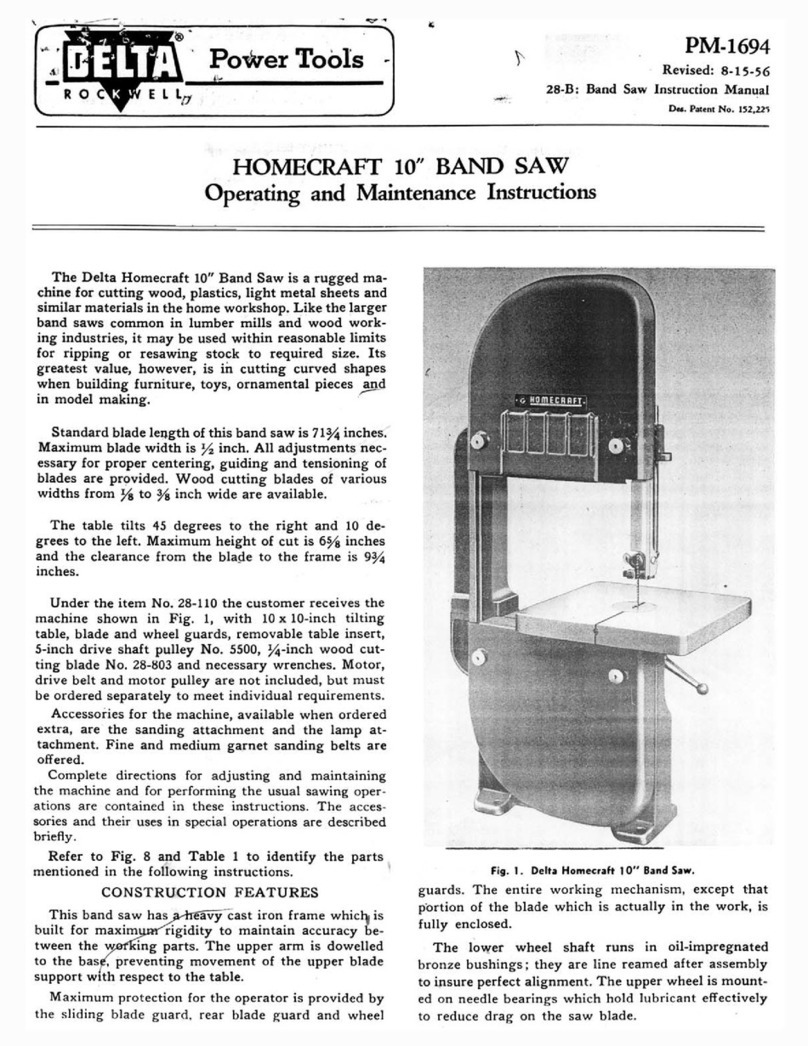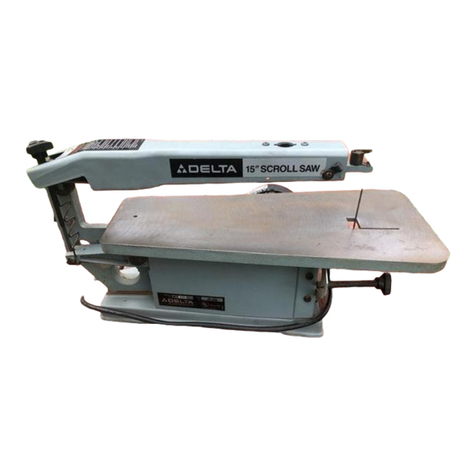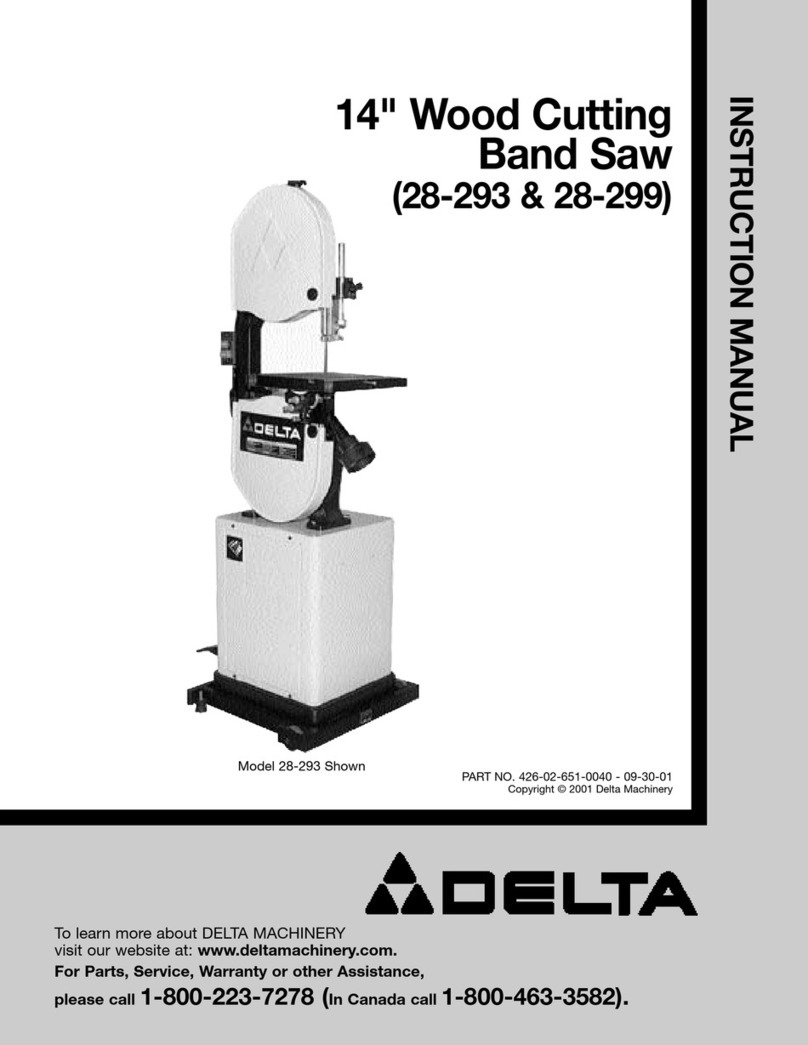Delta 36-412 User manual

INSTRUCTION MANUAL
ESPAÑOL: PÁGINA 23
To learn more about DELTA MACHINERY
visit our website at: www.deltamachinery.com.
For Parts, Service, Warranty or other Assistance,
please call 1-800-223-7278 (In Canada call 1-800-463-3582).
12" Dual-Bevel Compound
Miter Saw
(Model 36-412)
PART NO. A05726 - 10-21-04
Copyright © 2004 Delta Machinery

2
TABLE OF CONTENTS
Read and understand all warnings and operating instructions before using any tool or equipment. When
using tools or equipment, basic safety precautions should always be followed to reduce the risk of personal injury.
Improper operation, maintenance or modification of tools or equipment could result in serious injury and property
damage. There are certain applications for which tools and equipment are designed. Delta Machinery strongly
recommends that this product NOT be modified and/or used for any application other than for which it was designed.
If you have any questions relative to its application DO NOT use the product until you have written Delta Machinery
and we have advised you.
Online contact form at www.deltamachinery.com
Postal Mail: Technical Service Manager
Delta Machinery
4825 Highway 45 North
Jackson, TN 38305
Information regarding the safe and proper operation of this tool is available from the following sources:
Power Tool Institute
1300 Sumner Avenue, Cleveland, OH 44115-2851
www.powertoolinstitute.org
National Safety Council
1121 Spring Lake Drive, Itasca, IL 60143-3201
American National Standards Institute, 25 West 43rd Street, 4 floor, New York, NY 10036 www.ansi.org
ANSI 01.1Safety Requirements for Woodworking Machines, and
the U.S. Department of Labor regulations www.osha.gov
IMPORTANT SAFETY INSTRUCTIONS
SAVE THESE INSTRUCTIONS!
IMPORTANT SAFETY INSTRUCTIONS . . . . . . . . . . . . . . . . . . . . . . . . . . . . . . . . . . . . . . . . . . . . . . . . . . . . . . . . . . .2
SAFETY GUIDELINES . . . . . . . . . . . . . . . . . . . . . . . . . . . . . . . . . . . . . . . . . . . . . . . . . . . . . . . . . . . . . . . . . . . . . . . .3
GENERAL SAFETY RULES . . . . . . . . . . . . . . . . . . . . . . . . . . . . . . . . . . . . . . . . . . . . . . . . . . . . . . . . . . . . . . . . . . . .4
ADDITIONAL SPECIFIC SAFETY RULES . . . . . . . . . . . . . . . . . . . . . . . . . . .. . . . . . . . . . . . . . . . . . . . . . . . . . . . . .5
FUNCTIONAL DESCRIPTION . . . . . . . . . . . . . . . . . . . . . . . . . . . . . . . . . . . . . . . . . . . . . . . . . . . . . . . . . . . . . . . . . .7
CARTON CONTENTS . . . . . . . . . . . . . . . . . . . . . . . . . . . . . . . . . . . . . . . . . . . . . . . . . . . . . . . . . . . . . . . . . . . . . . . . .7
ASSEMBLY . . . . . . . . . . . . . . . . . . . . . . . . . . . . . . . . . . . . . . . . . . . . . . . . . . . . . . . . . . . . . . . . . . . . . . . . . . . . . . . . .8
OPERATIONS . . . . . . . . . . . . . . . . . . . . . . . . . . . . . . . . . . . . . . . . . . . . . . . . . . . . . . . . . . . . . . . . . . . . . . . . . . . . . .10
TROUBLESHOOTING . . . . . . . . . . . . . . . . . . . . . . . . . . . . . . . . . . . . . . . . . . . . . . . . . . . . . . . . . . . . . . . . . . . . . . .19
MAINTENANCE . . . . . . . . . . . . . . . . . . . . . . . . . . . . . . . . . . . . . . . . . . . . . . . . . . . . . . . . . . . . . . . . . . . . . . . . . . . . .19
SERVICE . . . . . . . . . . . . . . . . . . . . . . . . . . . . . . . . . . . . . . . . . . . . . . . . . . . . . . . . . . . . . . . . . . . . . . . . . . . . . . . . . .21
ACCESSORIES . . . . . . . . . . . . . . . . . . . . . . . . . . . . . . . . . . . . . . . . . . . . . . . . . . . . . . . . . . . . . . . . . . . . . . . . . . . .21
WARRANTY . . . . . . . . . . . . . . . . . . . . . . . . . . . . . . . . . . . . . . . . . . . . . . . . . . . . . . . . . . . . . . . . . . . . . . . . . . . . . . . .22
ESPAÑOL . . . . . . . . . . . . . . . . . . . . . . . . . . . . . . . . . . . . . . . . . . . . . . . . . . . . . . . . . . . . . . . . . . . . . . . . . . . . . . . . . .23
SERVICE CENTER LOCATIONS . . . . . . . . . . . . . . . . . . . . . . . . . . . . . . . . . . . . . . . . . . . . . . . . . . . . . . . .back cover

3
Indicates an imminently hazardous situation which, if not avoided, will result in death or serious injury.
Indicates a potentially hazardous situation which, if not avoided, could result in death or serious injury.
Indicates a potentially hazardous situation which, if not avoided, may result in minor or moderate injury.
Used without the safety alert symbol indicates potentially hazardous situation which, if not avoided, may
result in property damage.
It is important for you to read and understand this manual. The information it contains relates to protecting YOUR
SAFETY and PREVENTING PROBLEMS. The symbols below are used to help you recognize this information.
SAFETY GUIDELINES - DEFINITIONS
SOME DUST CREATED BY POWER SANDING, SAWING, GRINDING, DRILLING, AND OTHER
CONSTRUCTION ACTIVITIES contains chemicals known to cause cancer, birth defects or other reproductive harm.
Some examples of these chemicals are:
· lead from lead-based paints,
· crystalline silica from bricks and cement and other masonry products, and
· arsenic and chromium from chemically-treated lumber.
Your risk from these exposures varies, depending on how often you do this type of work. To reduce your exposure to
these chemicals: work in a well ventilated area, and work with approved safety equipment, always wear MSHA/NIOSH
approved, properly fitting face mask or respirator when using such tools.
CALIFORNIA PROPOSITION 65

4
GENERAL SAFETY RULES
1. FOR YOUR OWN SAFETY, READ THE INSTRUC-
TION MANUAL BEFORE OPERATING THE
MACHINE. Learning the machine’s application,
limitations, and specific hazards will greatly mini-
mize the possibility of accidents and injury.
2. USE CERTIFIED SAFETY EQUIPMENT. Eye
protection equipment should comply with ANSI
Z87.1 standards, hearing equipment should
comply with ANSI S3.19 standards, and dust
mask protection should comply with
MSHA/NIOSH certified respirator standards.
Splinters, air-borne debris, and dust can cause
irritation, injury, and/or illness.
3. DRESS PROPERLY. Do not wear tie, gloves, or
loose clothing. Remove watch, rings, and other
jewelry. Roll up your sleeves. Clothing or jewelry
caught in moving parts can cause injury.
4. DO NOT USE THE MACHINE IN A DANGEROUS
ENVIRONMENT. The use of power tools in damp
or wet locations or in rain can cause shock or
electrocution. Keep your work area well-lit to
prevent tripping or placing arms, hands, and
fingers in danger.
5. MAINTAIN ALL TOOLS AND MACHINES IN PEAK
CONDITION. Keep tools sharp and clean for best and
safest performance. Follow instructions for lubricating
and changing accessories. Poorly maintained tools and
machines can further damage the tool or machine and/or
cause injury.
6. CHECK FOR DAMAGED PARTS. Before using the
machine, check for any damaged parts. Check for
alignment of moving parts, binding of moving
parts, breakage of parts, and any other conditions
that may affect its operation. A guard or any other
part that is damaged should be properly
repaired or replaced. Damaged parts can cause
further damage to the machine and/or injury.
7. KEEP THE WORK AREA CLEAN. Cluttered areas and
benches invite accidents.
8. KEEP CHILDREN AND VISITORS AWAY. Your shop is
a potentially dangerous environment. Children and
visitors can be injured.
9. REDUCE THE RISK OF UNINTENTIONAL
STARTING. Make sure that the switch is in the
“OFF” position before plugging in the power cord.
In the event of a power failure, move the switch to
the “OFF” position. An accidental start-up can
cause injury.
10. USE THE GUARDS. Check to see that all guards
are in place, secured, and working correctly to
prevent injury.
11. REMOVE ADJUSTING KEYS AND WRENCHES
BEFORE STARTING THE MACHINE. Tools,
scrap pieces, and other debris can be thrown at
high speed, causing injury.
12. USE THE RIGHT MACHINE. Don’t force a
machine or an attachment to do a job for which it
was not designed. Damage to the machine and/or
injury may result.
13. USE RECOMMENDED ACCESSORIES. The use
of accessories and attachments not recommend-
ed by Delta may cause damage to the machine or
injury to the user.
14. USE THE PROPER EXTENSION CORD. Make
sure your extension cord is in good condition.
When using an extension cord, be sure to use one
heavy enough to carry the current your product will
draw. An undersized cord will cause a drop in line
voltage, resulting in loss of power and overheating.
See the Extension Cord Chart for the correct size
depending on the cord length and nameplate
ampere rating. If in doubt, use the next heavier
gauge. The smaller the gauge number, the heavier
the cord.
15. SECURE THE WORKPIECE. Use clamps or a vise to
hold the workpiece when practical. Loss of control
of a workpiece can cause injury.
16. FEED THE WORKPIECE AGAINST THE DIRECTION
OF THE ROTATION OF THE BLADE, CUTTER, OR
ABRASIVE SURFACE. Feeding it from the other
direction will cause the workpiece to be thrown out
at high speed.
17. DON’T FORCE THE WORKPIECE ON THE
MACHINE. Damage to the machine and/or injury
may result.
18. DON’T OVERREACH. Loss of balance can make
you fall into a working machine, causing injury.
19. NEVER STAND ON THE MACHINE. Injury could occur if
the tool tips, or if you accidentally contact the cutting tool.
20. NEVER LEAVE THE MACHINE RUNNING UNATTEN-
DED. TURN THE POWER OFF. Don’t leave the machine
until it comes to a complete stop. A child or visitor could
be injured.
21. TURN THE MACHINE “OFF”, AND DISCONNECT THE
MACHINE FROM THE POWER SOURCE before
installing or removing accessories, before adjusting
or changing set-ups, or when making repairs. An
accidental start-up can cause injury.
22. MAKE YOUR WORKSHOP CHILDPROOF WITH
PADLOCKS, MASTER SWITCHES, OR BY
REMOVING STARTER KEYS. The accidental
start-up of a machine by a child or visitor could
cause injury.
23. STAY ALERT, WATCH WHAT YOU ARE DOING,
AND USE COMMON SENSE. DO NOT USE THE
MACHINE WHEN YOU ARE TIRED OR UNDER
THE INFLUENCE OF DRUGS, ALCOHOL, OR
MEDICATION. A moment of inattention while
operating power tools may result in injury.
24. THE DUST GENERATED by certain woods and
wood products can be injurious to your health.
Always operate machinery in well-ventilated areas,
and provide for proper dust removal. Use wood
dust collection systems whenever possible.
FAILURE TO FOLLOW THESE RULES MAY RESULT IN SERIOUS INJURY.

5
ADDITIONAL SAFETY RULES FOR MITER SAWS
Refer to them often
and use them to instruct others.
FAILURE TO FOLLOW THESE RULES MAY RESULT IN SERIOUS INJURY.
SAVE THESE INSTRUCTIONS.
1. DO NOT OPERATE THIS MACHINE until it is completely
assembled and installed according to the instructions. A
machine incorrectly assembled can cause serious injury.
2. OBTAIN ADVICE from your supervisor, instructor, or
another qualified person if you are not thoroughly familiar
with the operation of this machine. Knowledge is safety.
3. FOLLOW ALL WIRING CODES and recommended
electrical connections to prevent shock or electrocution.
4. SECURE THE MACHINE TO A SUPPORTING SURFACE.
Vibration can possibly cause the machine to slide, walk,
or tip over, causing serious injury.
5. USE ONLY CROSSCUT SAW BLADES. Use only zero-
degree or negative hook angles when using carbide-
tipped blades. Do not use blades with deep gullets.
These can deflect and contact the guard, and can cause
damage to the machine and/or serious injury.
6. USE ONLY BLADES OF THE CORRECT SIZE AND
TYPE specified for this tool to prevent damage to the
machine and/or serious injury.
7. USE A SHARP BLADE. Check the blade to see if it runs
true and is free from vibration. A dull blade or a vibrating
blade can cause damage to the machine and/or serious
injury.
8. INSPECT BLADE FOR CRACKS or other damage prior
to operation. A cracked or damaged blade can come
apart and pieces can be thrown at high speeds, causing
serious injury. Replace cracked or damaged blades
immediately.
9. CLEAN THE BLADE AND BLADE FLANGES prior to
operation. Cleaning the blade and flanges allows you to
check for any damage to the blade or flanges. A cracked
or damaged blade or flange can come apart and pieces
can be thrown at high speeds, causing serious injury.
10. USE ONLY BLADE FLANGES specified for this tool to
prevent damage to the machine and/or serious injury.
11. CLEAR THE AREA OF FLAMMABLE LIQUIDS and/or
gas prior to operation. Sparks can occur that would
ignite the liquids and cause a fire or an explosion.
12. CLEAN THE MOTOR AIR SLOTS of chips and sawdust.
Clogged motor air slots can cause the machine to
overheat, damaging the machine and possibly causing a
short which could cause serious injury.
13. TIGHTEN THE TABLE CLAMP HANDLE and any other
clamps prior to operation. Loose clamps can cause parts
or the workpiece to be thrown at high speeds.
14. NEVER START THE TOOL with the blade against the
workpiece. The workpiece can be thrown, causing
serious injury.
15. KEEP ARMS, HANDS, AND FINGERS away from the
blade to prevent severe cuts. Clamp all workpieces that
would cause your hand to be in the “Table Hazard Zone”
(within the red lines).
16. WHEN CUTTING WITH A COMPOUND SLIDING
MITER SAW, PUSH THE SAW FORWARD (AWAY
FROM YOU) and toward the fence. Pulling the saw
toward you can cause the saw to kick upward and
toward you.
17. WHEN USING A SLIDING MITER SAW AS A REGULAR
MITER SAW, LOCK THE SLIDE MECHANISM IN PLACE.If
the slide mechanism is not locked, the saw can kick
back toward you.
18. ALLOW THE MOTOR TO COME TO FULL SPEED prior
to starting cut. Starting the cut too soon can cause
damage to the machine or blade and/or serious injury.
19. NEVER REACH AROUND or behind the saw blade. A
moving blade can cause serious injury.
20. NEVER CUT FERROUS METALS or masonry. Either of
these can cause the carbide tips to fly off the blade at
high speeds causing serious injury.
21. NEVER CUT SMALL PIECES. Cutting small pieces can
cause your hand to move into the blade, resulting in
serious injury.
22. NEVER LOCK THE SWITCH in the “ON” position.
Setting up the next cut could cause your hand to move
into the blade, resulting in severe injury.
23. NEVER APPLY LUBRICANT to a running blade.
Applying lubricant could cause your hand to move into
the blade, resulting in serious injury.
24. DO NOT PERFORM FREE-HAND OPERATIONS. Hold
the work firmly against the fence and table. Free-hand
operations on a miter saw could cause the workpiece to
be thrown at high speeds, causing serious injury. Use
clamps to hold the work when possible.
25. PROPERLY SUPPORT LONG OR WIDE WORK-
PIECES. Loss of control of the workpiece can cause
serious injury.
26. AFTER COMPLETING CUT, release power switch and
wait for coasting blade to come to a complete stop
before returning saw to raised position. A moving blade
can cause serious injury.
27. TURN OFF THE MACHINE and allow the blade to come
to a complete stop prior to cleaning the blade area or
removing debris in the path of the blade. A moving blade
can cause serious injury.
28. TURN OFF MACHINE and allow the blade to come to a
complete stop before removing or securing workpiece,
changing workpiece angle, or changing the angle of the
blade. A moving blade can cause serious injury.
29. PROPERLY SUPPORT LONG OR WIDE WORK-
PIECES. Loss of control of the workpiece can cause injury.
30. NEVER PERFORM LAYOUT, ASSEMBLY, OR SET-UP
WORK on the table/work area when the machine is
running. A sudden slip could cause a hand to move into
the blade. Severe injury can result.
31. TURN THE MACHINE “OFF”, disconnect the machine
from the power source, and clean the table/work area
before leaving the machine. LOCK THE SWITCH IN THE
“OFF” POSITION to prevent unauthorized use.
Someone else might accidentally start the machine and
cause injury to themselves.
32. BEFORE OPERATING THE SAW, check and securely
lock the bevel, miter, and sliding fence adjustments.
33. ADDITIONAL INFORMATION regarding the safe and
proper operation of power tools (i.e. a safety video) is
available from the Power Tool Institute, 1300 Sumner
Avenue, Cleveland, OH 44115-2851 (www.powertool
institute.com). Information is also available from the
National Safety Council, 1121 Spring Lake Drive, Itasca,
IL 60143-3201. Please refer to the American National
Standards Institute ANSI 01.1 Safety Requirements for
Woodworking Machines and the U.S. Department of
Labor regulations.
Table of contents
Other Delta Saw manuals
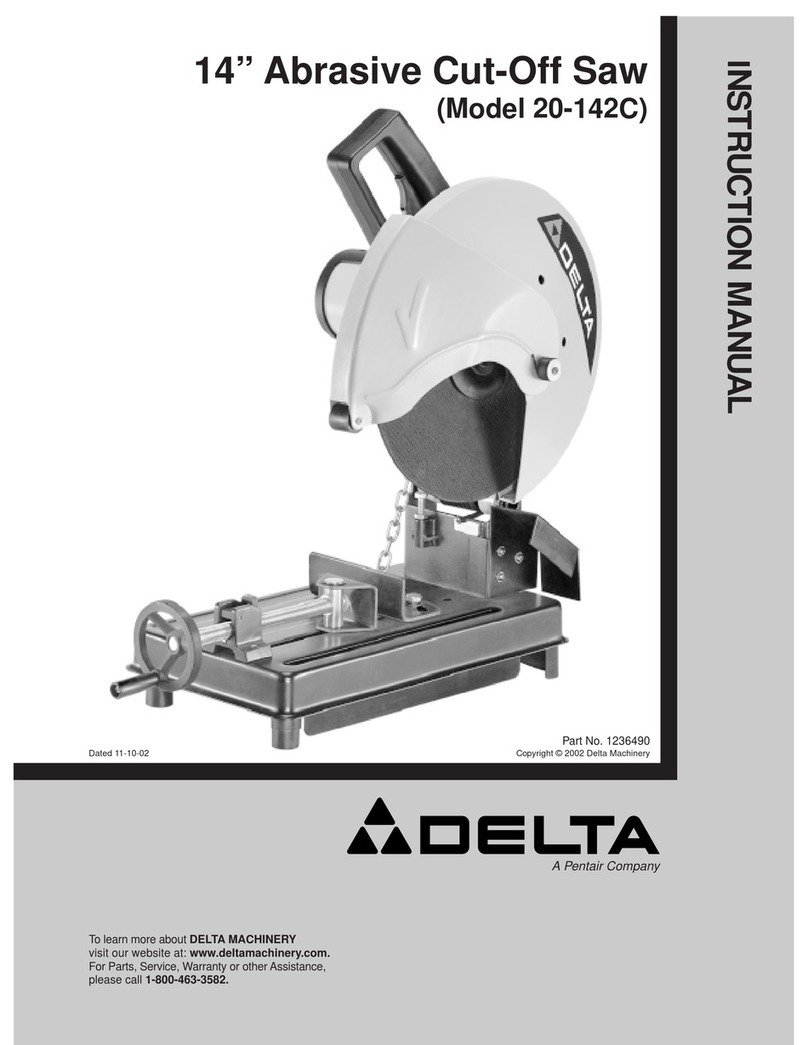
Delta
Delta 20-142C User manual
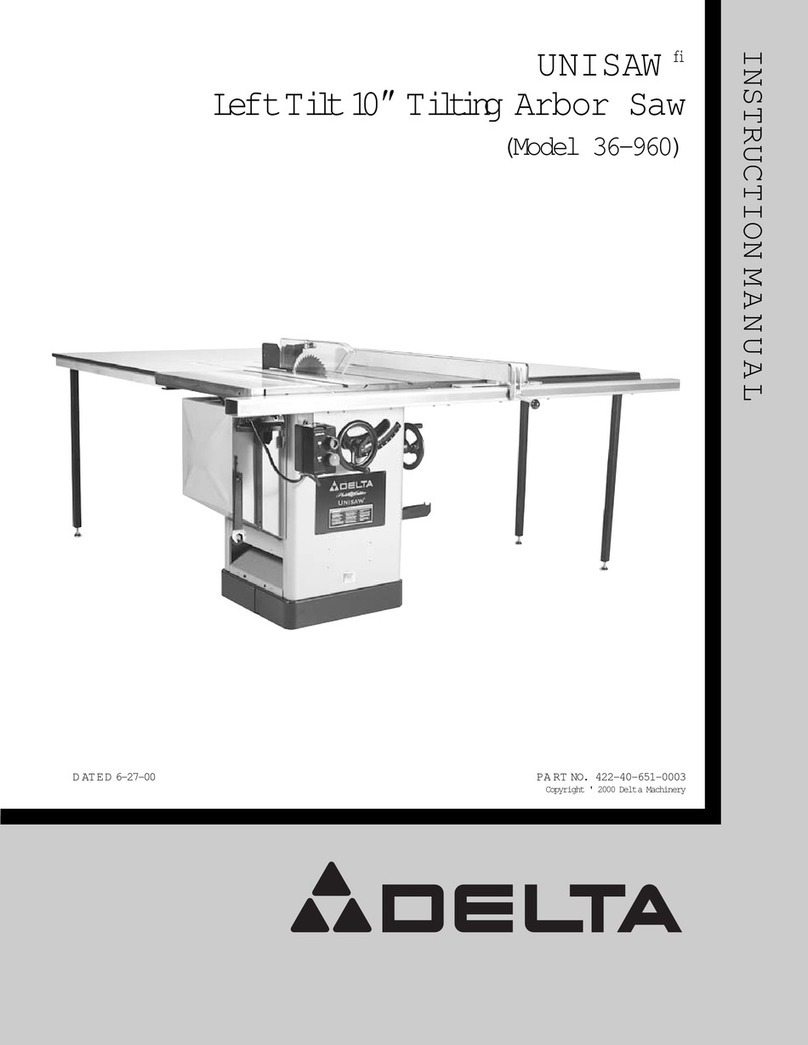
Delta
Delta 36-960 User manual
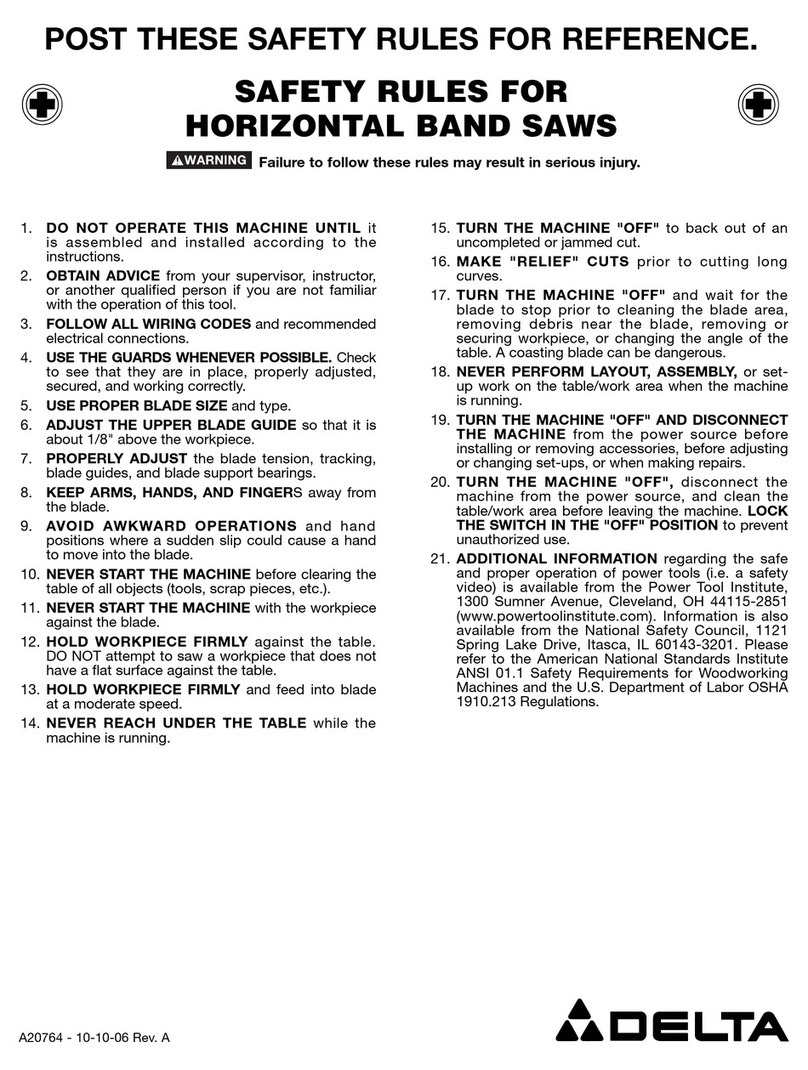
Delta
Delta Horizontal Band Saw User guide

Delta
Delta 36-650 User manual
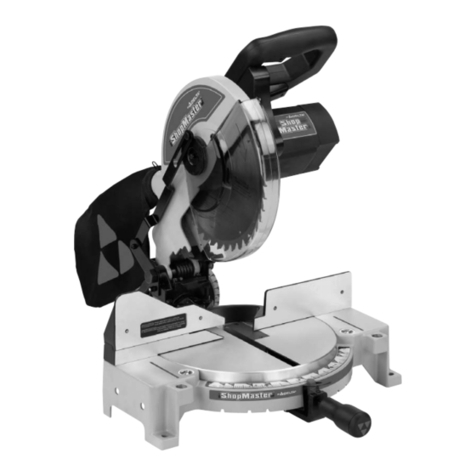
Delta
Delta 90513776 User manual

Delta
Delta 36-220 User manual
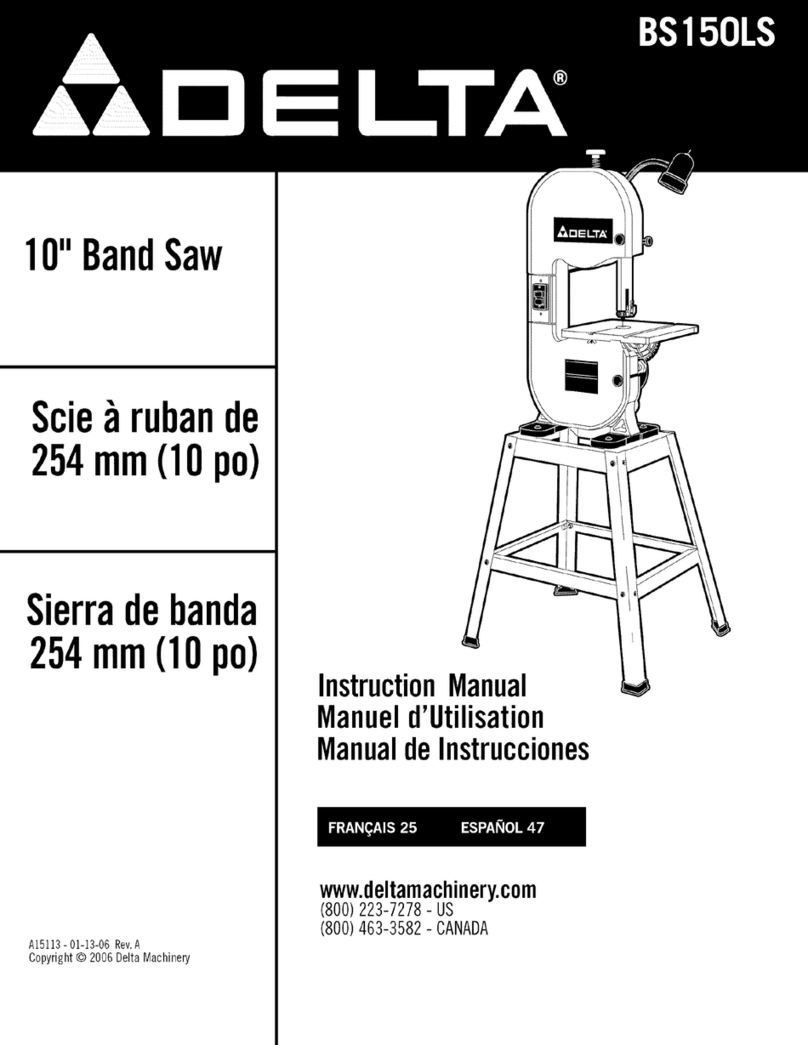
Delta
Delta ShopMaster BS150LS User manual

Delta
Delta 20-150 User manual
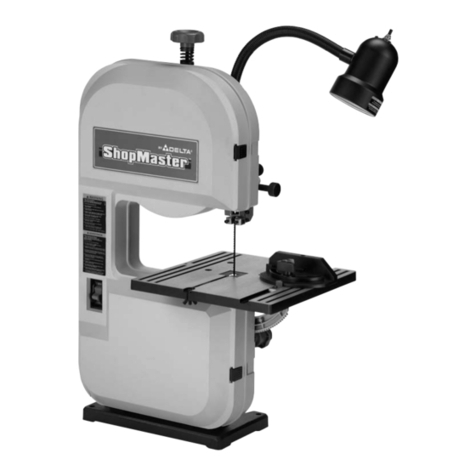
Delta
Delta ShopMaster 638518-00 User manual
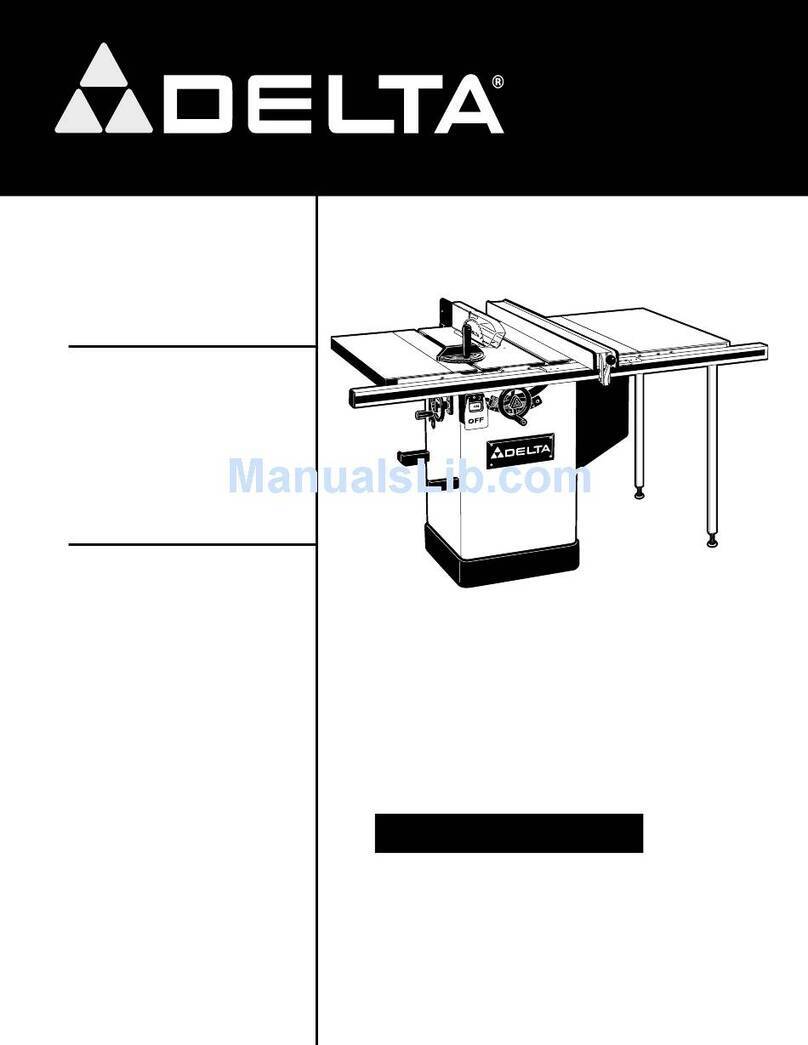
Delta
Delta 36-714 User manual

Delta
Delta 28-275 User manual
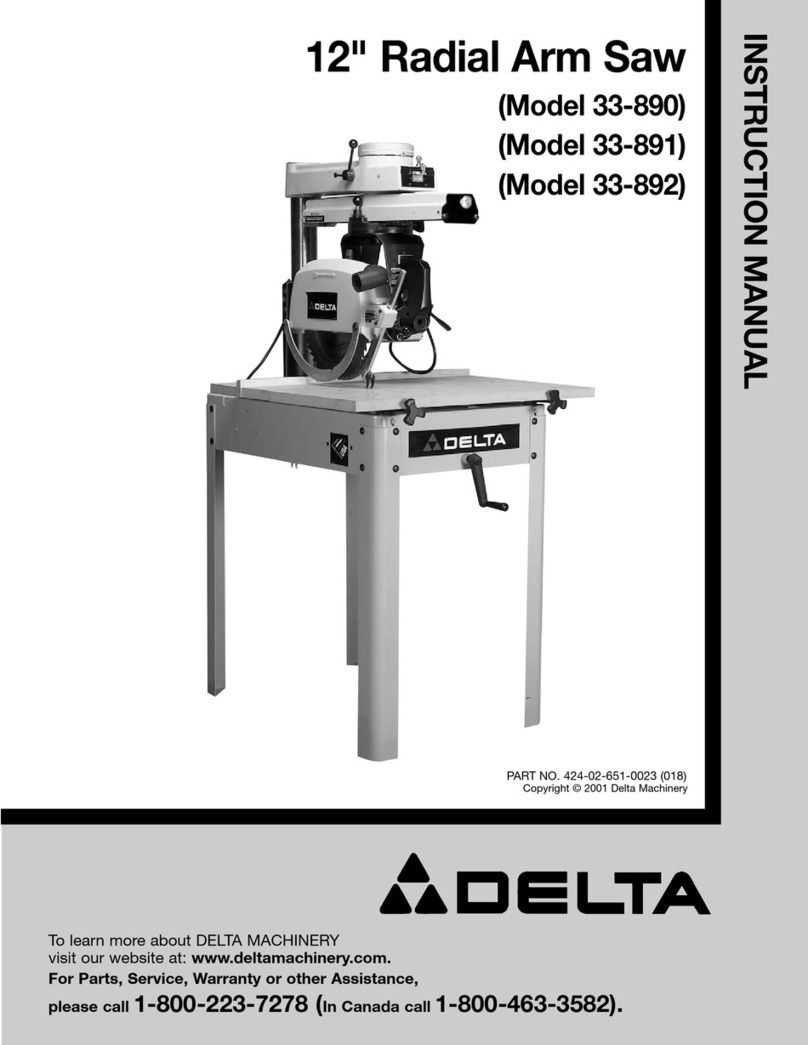
Delta
Delta 33-891 User manual
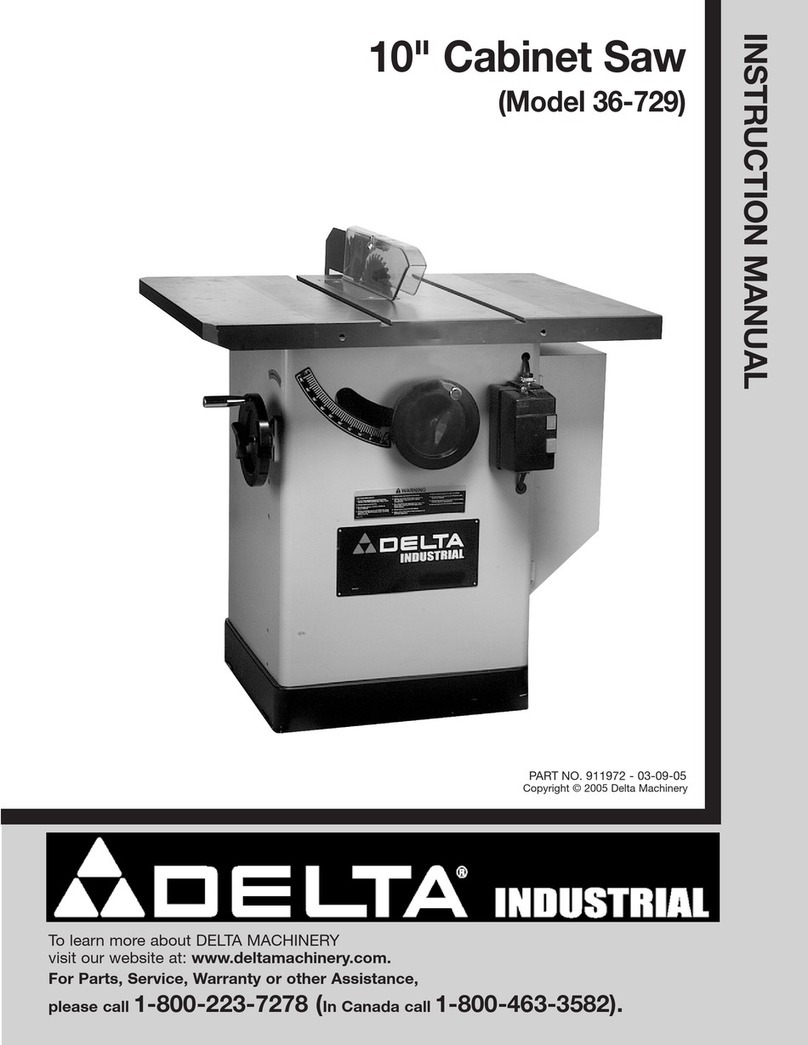
Delta
Delta 36-729 User manual
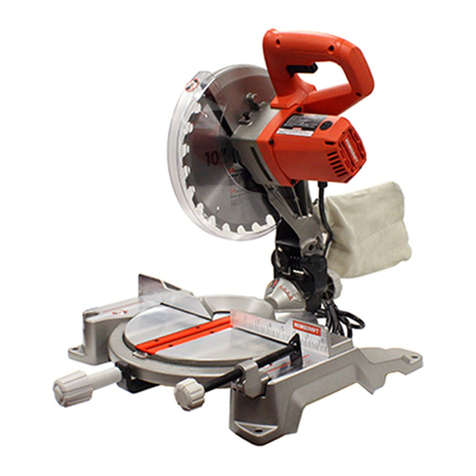
Delta
Delta HOMECRAFT H26-260L User manual
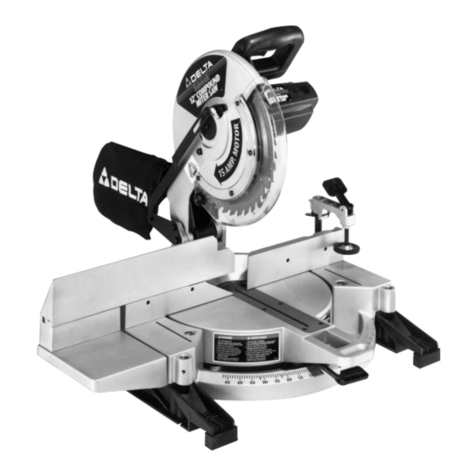
Delta
Delta Sidekick 36-235 User manual
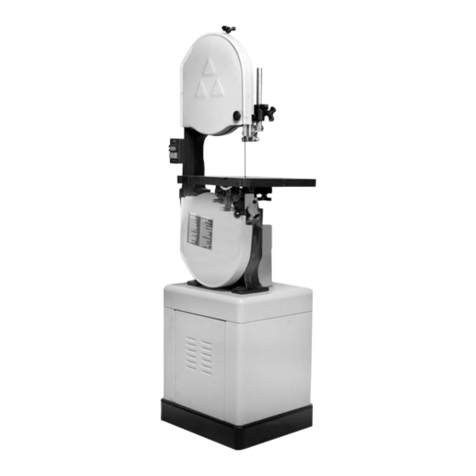
Delta
Delta 28-280 User manual
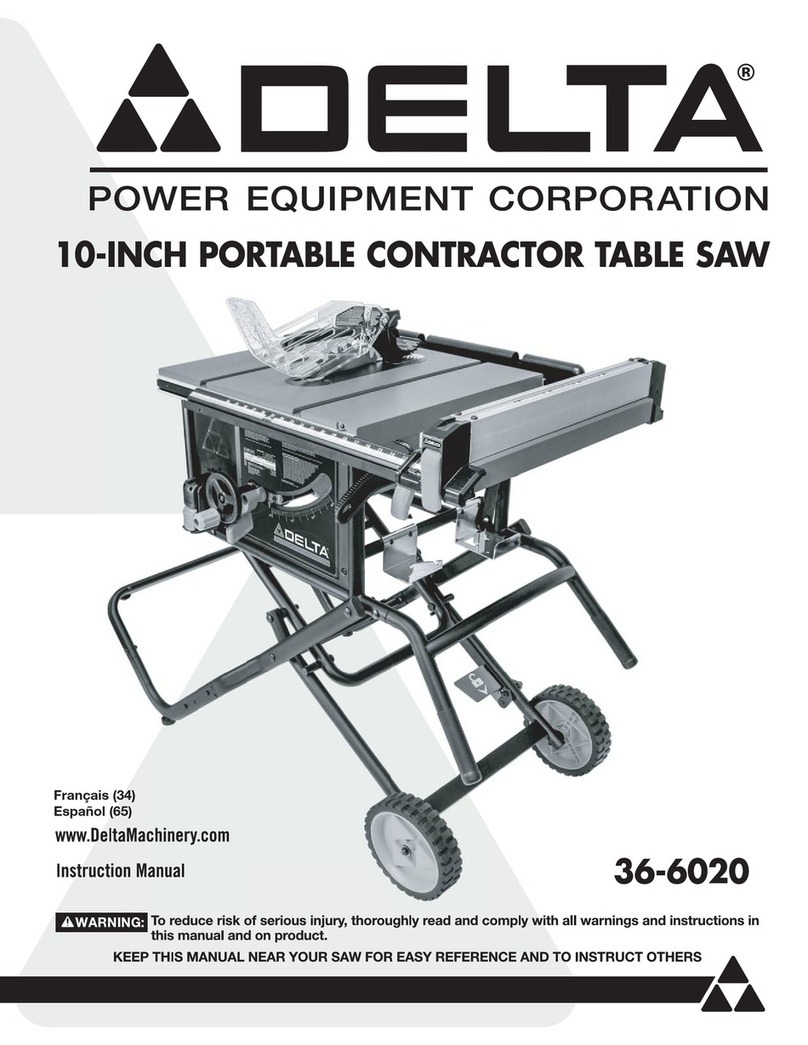
Delta
Delta 36-6020 User manual

Delta
Delta RT-40 User manual

Delta
Delta 26-2240 User manual
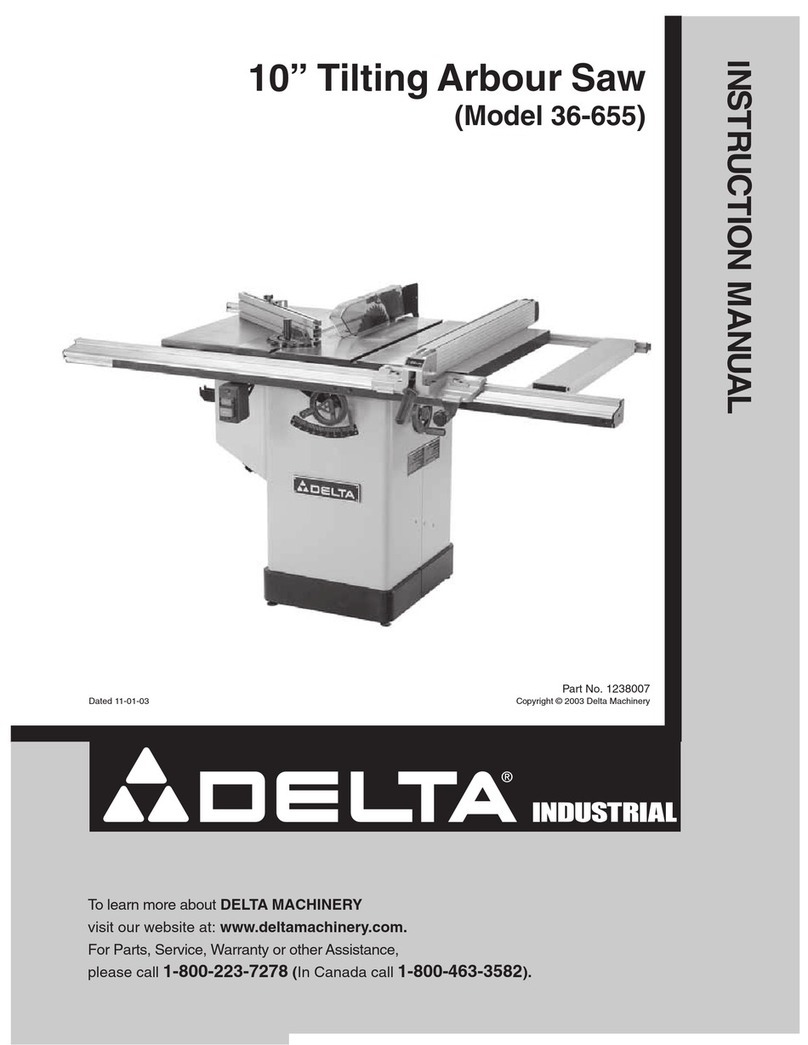
Delta
Delta 36-655 User manual

